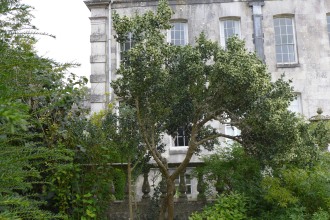Position: Full sun
Flowering period: Late summer to autumn
Soil: Moist, well drained
Eventual Height: 3m
Eventual Spread: 3m
Hardiness: 8a, 8b, 9a, 9b, 10a, 10b, 11
Family: Rhamnaceae
Colletia paradoxa is a slow growing evergreen shrub with a rounded, bushy habit. Its blue/ green fleshy leaves (actually flattened stems) are triangular with entire margins and a sharp spine at its tip, up to 2.5cm long and 1.5cm across. Its white/ cream fragrant flowers are tubular and appear in small clusters in the ‘leaf’ axils.
Colletia paradoxa, commonly known as Anchor Plant, Thorn of the Cross, Crown of the Cross or Crucifixion Thorn, is native to South America including south Brazil, west Argentina and Uruguay. Colletia paradoxa is synonymous with Colletia cruciata. In its native habitat this plant is under threat of extinction.
The etymological root of the binomial name Colletia is named after Philibert Collet (1643-1718), a French botanist. Paradoxa is derived from the Greek paradocos meaning ‘incredible’.
The landscape architect may find Colletia paradoxa useful as part of xeriscaping planting scheme. Care should be taken when locating this plan due to its thorny nature. Once established this plant is drought tollerant.
Ecologically, Colletia paradoxa flowers are attractive to pollinating insects.
Colletia paradoxa prefers moist, fertile, fast draining soils. It tolerates most pH of soil. It dislikes wet soils.
Colletia paradoxa requires little maintenance. Necessary pruning should be carried out in late winter to early spring.
![]()
Landscape Architecture












